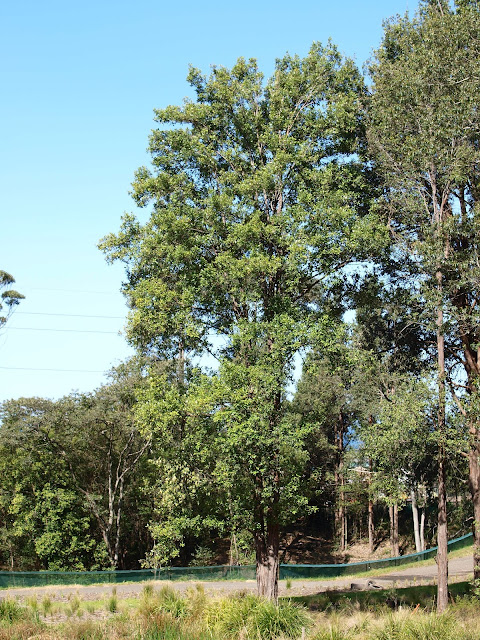Owned by the local council and managed by adjacent land-owners, the verge is a site full of potential for urban biodiversity, if only we could get our collective acts together. And this is perfectly possible! If you have a verge outside your place (and it doesn't have overhead power lines), chances are that you can work with your council to get a native tree or two planted. The council will probably prefer to do the planting, but if you volunteer for watering and weeding they are likely to give you what you want.
 |
| A young White Aspen (Acronychia oblongifolia) planted in Fairy Meadow as part of a street tree planting trial. Image by Emma Rooksby. |
 |
| Red Ash (Alphitonia excelsa) is a tried and true native tree for a range of conditions. It doesn't shed messy fruit and attracts a range of birds. Image by Mithra Cox, reproduced under CC BY-NC 2.0. |
 |
| Swamp Mahogany (Eucalyptus robusta) is a great small eucalypt that grows well on most soils of the region. Image by Mithra Cox, reproduced under CC BY-NC 2.0. |
 |
| Many rainforest species make great street trees. Here is a Brush Cherry (Syzygium australe) doing well in full sun on the escarpment foothills. Image by Mithra Cox, reproduced under CC BY-NC 2.0. |
 |
| Boobialla (Myoporum acuminatum) does not always form such a neat shapely tree as this, but when it does, it is one of the most attractive local tree species. Image by Byron Cawthorne-McGregor. |
 |
| And last but not least, the mighty Turpentine (Syncarpia glomulifera), a large tree, but one that provides outstanding habitat for local fauna. Image by Byron Cawthorne-McGregor. |
These are just a few of the local tree species that can be grown on verges. Councils might offer you Water Gum (Tristaniopsis laurina) or Tuckeroo (Cupaniopsis anarcardioides), but these are already widely planted well outside their natural distribution, so try asking for something different!
Let us know in the comments how you go!



No comments
Post a Comment